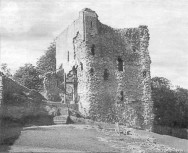Review of ‘A History of Derbyshire’, by Gladwyn TurbuttThis review is by Julie Bunting, and was published originally in The Peak Advertiser, the Peak District's local free newspaper, on 5th June 2000, and is reproduced with Julie's kind permission.
Gladwyn Turbutt is the representative of the family which has owned up land in Derbyshire since the 18th century and whose home was until recently Ogston Hall, an estate with a history predating Domesday. Mr Turbutt, a Deputy Lieutenant for Derbyshire, was also HIgh Sheriff of Derbyshire in 1998-9 and has been president of the Derbyshire Record Society since its inception in 1977. Declaring himself encouraged by expanding interest in the history of Derbyshire, with a wider appreciation of local records by local people, the author himself is a researcher par excellence. His book opens with a survey of the geography and Derbyshire - surprising us with the revelation that Bleaklow is Britain's only true desert - before settling into a chronological account of the county's history from prehistoric times to the present day. By combining over-views with the work of earlier writers and irreproachable academic sources, every era and subject is covered in considerable depth. The author explains that the county boundaries have not altered significantly since they began to take shape in the 10th century, adding that Derbyshire was one of half a dozen counties given by Richard I to his brother, the future King John. Major and minor topics range from topography, political history, economy, industry, transport, religious, cultural and social history to the military, merchants and architects. Farming is given due recognition throughout; for one thing we learn that 80% of Derbyshire land is used for agriculture and, for another, that today a typical wool fleece is over twice the weight of that of a medieval sheep. Talking of sheep, the first regimental mascot of the Derbyshire Regiment (the 95th) was a ram and acquired at the siege of Kotah during the Indian Mutiny in 1858. The ram up not only emerged victorious from thirty-three personal battles with other rams but marched more than 3,000 miles with the 95th and was present at six actions. The reader will be happily diverted by countless such vignettes - tales such as a reason why a West Indian sugar plantation came into the hands of the FitzHerberts of Tissington and the disclosure that the rent for one-third of a Winster leadmine was a pair of boots of Cordovan leather. Great men and women are re-awarded contemporary compliments, or not as the case may be, so that Sir Joseph Whitworth is recalled as 'a monumental egotist' while due credit is given to his micrometer shown at the Great Exhibition in 1851 and accurate to one-millionth of an inch. Notes are even taken from the margins of the early maps, i.e. Derbyshire lead was 'the best in all England' and the county brewed 'exceedingly good Ale'. Observations of early travellers are used extensively, enabling us to imagine for example the Georgian theatre at the Buxton as 'a mean, dirty, boarded, thatched house'. But A History of Derbyshire also takes advantage of 20th-century historical and archaeological research using modern techniques. Thus the work makes reference to the rediscovery of two more stone circles on Eyam Moor, the probability that the Nine Ladies of Stanton Moor were originally eleven, proof of the existence of a Roman fort at Chesterfield and evidence of a 4th-century building found during excavations for Carsington Water. As for 20th-century progress, it seems unbelievable now that prior to the Clean Air Act of 1964, around eight tons of soot used to fall on every square mile of heather per month - and the sheep were grimy to prove it. It would be an unrealistic to expect the minutiae of every source but each one is fully cited in footnotes supported by a bibliography which extends to over a thousand entries. The index itself runs to 46 pages. A History of Derbyshire is certain to be a significant reference work for generations to come, not only for the inhabitants and historians of its home county but for a far wider readership. Already it is attracting the envy of historians around the country and Derbyshire is exceptionally fortunate in having its story told in such readable style by one of its native sons. It must be especially rewarding to Gladwyn Turbutt, who has written extensively on the county's history, that his magnum opus is published at the dawn of the new millennium; not an easy thing to predict where 20 years of diligent research have been involved. It is dubious whether the work will ever be surpassed. At £120 the four-volume set will not be an impulse purchase but pound for pound (both £s and lbs.!) its informative value far exceeds a collection of less thorough publications. Review by Julie Bunting |
|||
